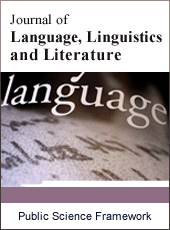Journal of Language, Linguistics and Literature
Articles Information
Journal of Language, Linguistics and Literature, Vol.1, No.1, Feb. 2015, Pub. Date: Jan. 28, 2015
On Trend-Restricted Theoretical Translation Studies: A Missing Link in Holmes’ Map
Pages: 1-6 Views: 10595 Downloads: 2406
[01]
Peyman Nouraey, Faculty of Foundation Studies, Gulf College, Muscat, Oman.
[02]
Amin Karimnia, Department of English Language, Fasa Branch, Islamic Azad University, Fasa, Iran.
Several systematic classifications have been made within the realm of Translation Studies (henceforth TS) up to the present day. Each of these issues tries to provide the ones working in the field with different aspects of translation. Regarded as the first classification of different aspects in TS, Holmes’ (1988) map of TS has gone under several revisions by a number of scholars (e.g., Gutt 2000, Pym 1998, Toury 1995, Zwart&Naaijkens1991, etc.). The present problem-restricted study aimed to investigate a branch which seemed to be dismissed within the Holmes’ map of TS, namely ‘trend-restricted theories’. The paper argues that this could be regarded as a missing branch in Holmes’ (ibid.) map of TS, distinguishing it from ‘time-restricted’ theories of translation. To do so, the map was introduced in a detailed way and further discussed. In order to prevent any clumsiness, the later-developed sub-branches pointed out by Toury (1995) were put into consideration, too. Finally, the paper argued the need for such sub-branch in the map.
Translation Studies, Trends, Theoretical Translation Studies, Translation History, Trend-Restricted Theories
[01]
Bassnett, S., & Lefevere, A. (1988). Bibliography of translation studies. Manchester: St. Jerome.
[02]
Bell, R. T. (1993). Translation and translating: Theory and practice. London: Longman.
[03]
Bowker, L., Cronin, M., Kenny, D., & Pearson, J. (1998). Unity in diversity? Current trends in translation studies. Manchester: St. Jerome.
[04]
Catford, J. C. (1965). A linguistic theory of translation: An essay in applied linguistics, London: Oxford University Press.
[05]
Chelliah, S. L., & Reuse, W. J. D. (2010). Handbook of descriptive linguistic fieldwork. New York: Springer.
[06]
European Society for Translation Studies (2003): European Society for Translation Studies Directory 2003, Birmingham, Les, Aston University.
[07]
Even-Zohar, I. (1990). Poly system studies. Poetics Today,11 (1).
[08]
Fraser, J. (1996). The translator investigated: Learning from translation process analysis. The Translator, 2(1), pp. 65-79.
[09]
Gaber, J. (2010). Applied research. In N. J. Salkind (Ed.), Encyclopedia of research design (pp. 35-37). Thousand Oaks, Calif.: SAGE Publications
[10]
Gutt, E. A. (2000). Translation and relevance: Cognition and context. Manchester: St. Jerome.
[11]
Holmes, J. S. (1988). The name and nature of translation studies, In L. Venuti (Ed.) The Translation Studies Reader. (pp.172-185). New York: Routledge.
[12]
Holz-Mänttäri, J. (1986) Translational action: Theories and methods. Helsinki: Suomalainen Tiedeakatemia.
[13]
Karimnia, A., &Nouraey, P. (2013). Towards a global model for translation studies trends: Is it the question of backing to square one?.Wulfenia,20 (9), pp. 145-155.
[14]
Krings, H. P. (1986), Translation problems and translation strategies of advanced German learners of French (L2), J. House and S. Blum-Kulka (eds.) Interlingual and Intercultural Communication, pp. 262-276.
[15]
Lan, Y., Dong, D., & Chiu, A. (2009). Research trend and methods in Translation Studies: A comparison between Taiwanese and international publications. Compilation and Translation Review, 2(2), pp. 177-191.
[16]
Levy, J. (1967). Translation as a decision process. The Hague: Mouton.
[17]
Liao, P. (2007). The review of current interpretation research publications in Taiwan. Studies of translation and interpretation, (10), pp. 189-217.
[18]
Lörscher, W. (1991). Translation performance, translation process, and translation strategies. Tübingen: Gunter Narr.
[19]
Munday, J. (2008). Introducing translation studies: Theories and applications (2nd Ed.). London: Routledge.
[20]
Naudé, J. A., (2002). Recent developments in translation studies. ActaTheologica, 22(1).
[21]
Nida, E. A., & Taber, C. R. (1969). The theory and practice of translation. Leiden: E. J. Brill.
[22]
Nouraey, P. & Karimnia, A. (2013). Research trends in translation studies: A case study in Iranian context. Motalea’at-e- Tarjome, 11 (42), pp.23-35.
[23]
Nouraey, P., & Karimnia, A. (2012). A meta-look at current translation studies trends in Iran: Insights from translation studies M.A theses. British Journal of Social Sciences, 1(1), pp. 94-116.
[24]
Olohan, M. (1998). The role of theory in enhancing the explanatory and predictive aspects of translation process research, Ph.D. thesis, UMIST.
[25]
Perry, F. L. (2005). Research in applied linguistics: Becoming a discerning consumer. Mahwah, N.J.: Lawrence Erlbaum Associates.
[26]
Pym, A. (1998). Method in translation history. Manchester: St. Jerome.
[27]
Snell-Hornby, M. (1995). Translation studies: An integrated approach. Amsterdam: John Benjamins.
[28]
Toury, G. (1995) Descriptive translation studies- And beyond, Amsterdam and Philadelphia, PA: John Benjamins.
[29]
Vandepitte, S. (2008). Remapping translation studies: Towards a translation studies ontology. Meta, 53(3), pp. 569-588.
[30]
Venuti, L. (2004). The Translation studies reader. New York: Routledge.
[31]
Williams, J.,&Chesterman, A. (2002). The map: A beginner’s guide to doing research in translation studies. Manchester: St. Jerome Publishing.
[32]
Zwart, K. M., &Naaijkens, A. B. (1991). Translation studies: The state of the art: Proceedings of the First James S Holmes Symposium on Translation Studies. Amsterdam/New York: Rodopi.

ISSN Print: 2381-7054
ISSN Online: 2381-7062
Current Issue:
Vol. 6, Issue 1, March Submit a Manuscript Join Editorial Board Join Reviewer Team
ISSN Online: 2381-7062
Current Issue:
Vol. 6, Issue 1, March Submit a Manuscript Join Editorial Board Join Reviewer Team
| About This Journal |
| All Issues |
| Open Access |
| Indexing |
| Payment Information |
| Author Guidelines |
| Review Process |
| Publication Ethics |
| Editorial Board |
| Peer Reviewers |


